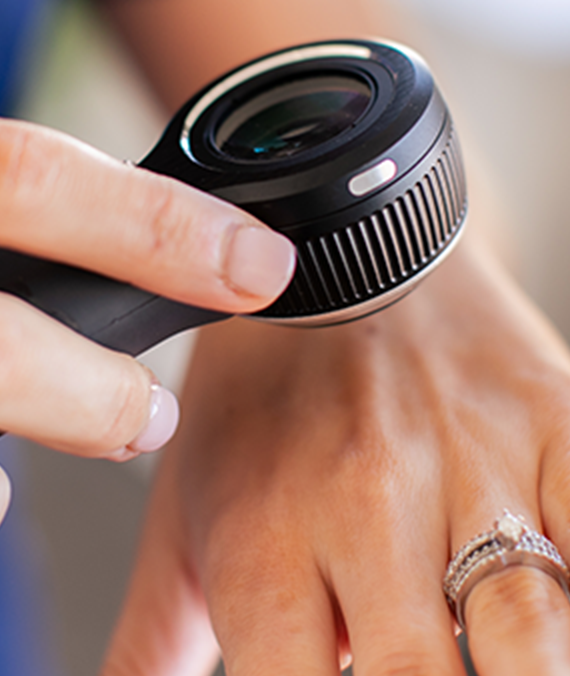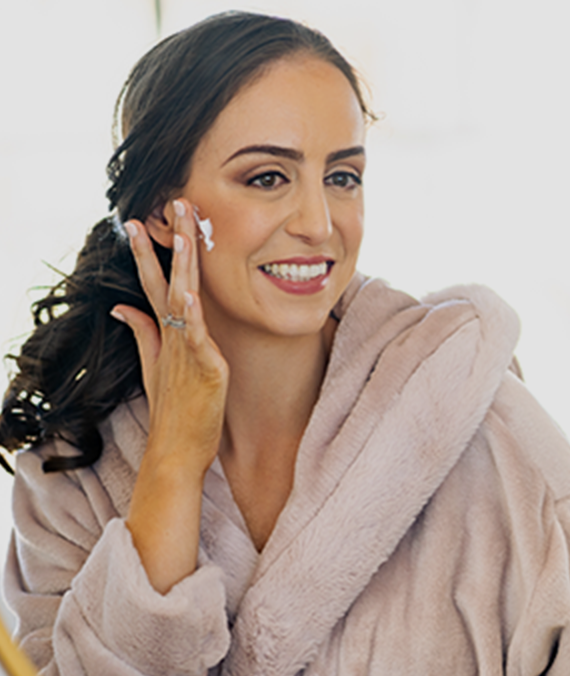Do you feel that? The warmth of the sun on your back as you take a stroll outside with your family with a cool beverage in hand. May is here which means longer days and summertime.
And I’m here for all of it!
But before you run out the door, you’ll want to protect yourself from the sun’s damaging ultraviolet (UV) rays. Skin cancer is the most common cancer worldwide and in the United States. In fact, 1 in 5 Americans will develop skin cancer in their lifetime. It’s a scary statistic, but the good news is there are ways to protect yourself from the sun.
May is Skin Cancer Awareness Month, so this month’s the perfect time to share with you my summer skincare routine “must-haves” for sun protection. If you’re ready to protect yourself from the sun but still have fun, keep reading.
Why Do You Need to Protect Your Skin From the Sun?
You saw the statistics about skin cancer above. But what actually happens when the sun touches your skin?
The Benefits of Sun Exposure
First, sun exposure is normal and has its benefits. Our ancestors spent longer periods of time outdoors, and nature brought benefits to their overall health. Plus, our skin uses sunlight to make vitamin D, an essential vitamin for healthy bones, immune system, and nervous system.
Sunlight helps us regulate our day and night cycles and helps improve mental health, especially during the winter months. And I don’t know about you, but this winter was a long one for me, so I’m really happy for these sunny days.
But there are some downsides if the sun is touching your skin for an extended period of time.
Your Skin’s Built-in Protector: Melanin
Your skin’s outer layer contains melanin, a biological molecule each of us has that determines the pigments of our skin. Darker-colored individuals contain more melanin than lighter-skinned individuals. Melanin’s job is to protect your skin from the sun’s UV rays. That’s why the less melanin you have, the more prone to sunburns you are.
So if you have fair skin, light-colored hair, freckles, and/or have lighted-colored eyes, then you’re more likely to get a sunburn. But this doesn’t mean darker-skinned individuals can’t get a sunburn. We should all protect our skin from the sun’s damaging UV rays.
Your skin tans thanks to sunlight causing your skin to produce more melanin and darken. But what happens when you get a sunburn?
The Biology Behind Sunburns
When UV rays touch our skin, they can also penetrate into deeper skin layers which can damage and even kill skin cells. This could lead to sunburns.
Have you ever had peeling skin after a bad burn? This is your skin’s outer layer shedding dead skin cells and replacing them. Your skin can go back to looking normal, but there are dangers to overexposing your skin to the sun.
As time goes on and your skin is continually exposed to the sun’s UV rays, your skin becomes less elastic. Elastic skin is smooth, tight, and when stretched can go back to its original position just like a rubber band. But non-elastic skin is leathery, saggy, and crinkled. These are normal things that happen when you age, but the sun’s damaging rays can accelerate this process.
The bottom line is, it’ll also be harder for your skin to repair itself the more often you expose it to the sun. The sun’s UV rays can damage your skin cells’ DNA leading to abnormal cells that can multiply and cause a tumor leading to skin cancer.
We want to avoid skin cancer at all costs, and the best way to do that is to protect your skin from the sun.
My Summertime Skincare Routine Must-Haves as a Dermatologist
If you’ve been part of my community for a while, you know there’s one thing I never leave my house without putting on – my sunscreen. It doesn’t matter the season: springtime, summertime, fall time, or wintertime. I’m incorporating sunscreen into my skincare routine.
All About Sunscreen: Facts from a Dermatologist
I shared important tips I use for my springtime skincare routine in this podcast episode. I carry these tips into my summertime routine too thanks to the warm months.
To give you a refresher from the podcast episode, I encouraged you to wear sunscreen with at least 30 SPF. I use sunscreens with SPF 50 in the summertime. I also reapply my sunscreen at least every two hours throughout the day. You should also be using a lip balm with SPF to protect your lips from getting burned.
SPF is a popular acronym you’ll see on all sunscreens which stands for “Sun Protection Factor.” It tells you the amount of time it’ll take the sun’s UV rays to burn your skin when using the product as directed versus the amount of time without any sunscreen. So, 30 SPF means it would take 30 times longer to burn your skin than it would with no sunscreen at all.
As far as sunscreen’s concerned, there are two types.
1. Physical Sunscreen
Picture it like that knight in shining armor with a shield. Physical sunscreens work like a shield by deflecting the sun’s UV rays when they’re on your skin. Active ingredients in physical sunscreens include zinc oxide and/or titanium dioxide. If you have sensitive skin, physical sunscreens are the best option for you.
2. Chemical Sunscreen
Instead of that knight in shining armor, think of chemical sunscreens as a sponge. Chemical sunscreens absorb the sun’s UV rays when they’re on your skin so that your skin doesn’t take a bad hit from them.
And another thing – contrary to marketing tactics, not everything that says “chemical” is bad. Active ingredients in chemical sunscreen products that are safe to use include octinoxate, oxybenzone, avobenzone, and octisalate. Chemical sunscreens are really easy to use and won’t leave that white residue on your skin from titanium dioxide in physical sunscreens.
We do know that chemical sunscreens have affected coral reefs and are banned in Hawaii and other islands. However, research shows that they are safe for human use.
If you’re spending time outdoors, be sure to reapply your sunscreen of choice every two hours. Ready to run out the door and enjoy nature with your fam? Use my favorite sun-protecting products below.
Disclaimer: Please note that this post contains affiliate links. I may receive a commission if clicked at no extra cost to you. I only recommend products that I’ve used myself and/or were recommended to me by other dermatologists. Thank you for your support.
1. Neutrogena’s Sheer Zinc Dry-Touch Sunscreen Broad Spectrum SPF 50
Neutrogena’s sunscreen is a physical sunscreen with zinc oxide. I’ve been using it for years. I love that it’s free of fragrances and doesn’t irritate my skin. It’s not greasy and won’t clog your pores.
The best part is it’s sweat and water-resistant: perfect for the heat here in Texas. I apply it to my face after applying my moisturizer every day. You can also use it on your neck and other body parts.
2. EltaMD UV Lip Balm Broad-Spectrum SPF 36
While you were probably using thick vaseline in the wintertime to keep your lips hydrated and moist, it’s time to switch to a summertime lip balm with SPF.
This will protect your delicate lips and also keep them hydrated. I use Elta’s UV Lip Balm which contains zinc oxide (a natural mineral compound) and vitamin E. I reapply my lip balm once every 2 hours or after meals.
3. Colorescience SunforgettableⓇ Total Protection Brush-On Shield SPF 50
“Dr. Nikoleta, if I’m supposed to reapply my sunscreen every two hours, won’t that ruin my make-up?”
I’ve been asked this question before, and I’ve got a product tested by dermatologists that I recommend. It’s a mess-free powder that you can apply over your make-up that has SPF. Pretty cool how a powder can act like sunscreen for your face, right?
It’s easy to use and apply, and also portable too. I recommend this sunscreen for everyday use.
4. Epionce Daily Shield Lotion Tinted SPF 50
If you’re not a fan of powder but you’re looking for make-up with coverage that includes SPF, I recommend Epionce’s tinted lotion with SPF 50. It’s a physical sunscreen that includes titanium dioxide and zinc oxide that’s great for all skin types (especially sensitive ones).
Overall, protecting your skin, lips, and eyes is key when it comes to UV rays. I recommend wearing a hat with a wide brim and sunglasses in addition to using products with SPF. I also recommend limiting your exposure to the sun’s most intense rays: between 10 am – 2 pm.
Now, it’s really important to protect your skin with SPF, but it’s also important to protect your little ones. Below are the tips that I use for my toddler to keep him safe.
Protecting Your Little Ones from the Sun
Each of us is prone to damaging our skin no matter what age we are. Here are three tips I use to keep my toddler protected from sun exposure.
1. Sunscreen for Toddlers
When my son turned 6 months old, I started using a physical, mineral-based sunscreen that contains zinc oxide and/or titanium dioxide.
If you have a child below the age of 6 months, I recommend keeping them in the shade and under a sun-protective covering. Overall, I recommend staying indoors with your child whenever possible, especially from 10 am-2 pm.
If you’re looking for a sunscreen, I recommend Neutrogena Pure & Free Baby Sunscreen Lotion. It’s easy to apply and safe for kids to use.
2. UPF Clothing, Hats, and Sunglasses
UV rays can damage you and your child’s skin and eyes, so it’s important to protect them. I recommend CoolibarⓇ infant clothing: they’re comfortable and soft for babies and provide the sun protecting their little body’s need.
3. Stay Indoors or Seek Shade
It’s important to protect your toddlers from the sun by using sunscreen and clothing. But if you can avoid the times of day when the sun is most intense, I’d encourage this.
If you’re with your family at the beach, camping, or enjoying a picnic, be sure to seek shade under a tree or bring an umbrella/tent canopy that can keep your child cool and also protected from the sun’s UV rays, especially during the peak hours of 10 am to 2 pm.
Be sure to observe your child to see if they’re comfortable in the heat and the sun. I hope these tips will be helpful during these upcoming months.
Let’s Have Some Fun in the Sun
I don’t know about you, but I’m ready to head to the beach. I’m grateful for these warm months and that we’ll be welcoming summer soon.
Are you ready to enjoy these summer months while also keeping you and your family’s skin safe? If you try any of the products I mentioned, be sure to tag me in your story on Instagram: @drnikoleta.
Now, let’s go have some fun in the sun this summertime.
I love you all!
Dr. Nikoleta







Stay in the know
Dropping in with weekly self-love affirmations, inspo, and skin secrets from Dr. Nikoleta created with YOU in mind.